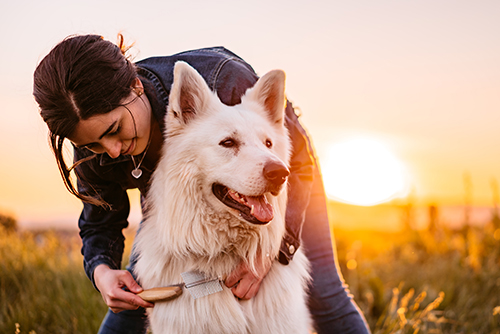Brush It Off
Jun 27, 2022

Consistent brushing of your dog’s fur is an important part of their health and happiness. However, while some may enjoy the chance to spend one-on-one time with you, others may squirm at the tugging of their fur. Follow the four tips listed below to make hesitant dogs more comfortable with the grooming process:
Research the specific grooming needs and brushing requirements of your dog’s breed before you get started. After all, a Siberian Husky will require much more frequent grooming than a short-haired Labrador. Brushing your dog two to three times a week is generally a good practice. Remember, you can never over-brush a dog, but they will likely let you know when they need a break.
To ensure that the time you spend grooming is effective, use a brush that is appropriate for your dog’s fur type. Common types of brushes include:
You will also need to keep a close eye on outdoor dogs because of the likelihood of getting thorns and cockleburs caught in their fur. If you own a working farm dog, frequently removing mats from their fur is especially essential. Matted fur can pull at your dog’s skin and cause irritation or even ulcers and wounds in some cases.
If you are unable to work the mats and tangles apart with your fingers, try using a brush or metal comb. If still unsuccessful, you may have to use dog clippers to remove the matted fur. Avoid using scissors due to the possibility of cutting your dog’s skin, which could lead to stitches or infection.
Your local Co-op carries a large selection of pet care products, including brushes to protect your dog after long days on the farm!
For more content like this, check out the latest issue of the Cooperator.
- Get your dog used to the sights, sounds, and sensations of being groomed while they are young.
- Start slow with sessions that last no longer than a few minutes before gradually increasing the duration.
- Offer rewards throughout the grooming process to encourage good behavior.
- Keep your routine consistent.
Research the specific grooming needs and brushing requirements of your dog’s breed before you get started. After all, a Siberian Husky will require much more frequent grooming than a short-haired Labrador. Brushing your dog two to three times a week is generally a good practice. Remember, you can never over-brush a dog, but they will likely let you know when they need a break.
To ensure that the time you spend grooming is effective, use a brush that is appropriate for your dog’s fur type. Common types of brushes include:
- Rakes – perfect for dogs with double coats due to its ability to penetrate thick coats and remove excess fur and tangles from the undercoat.
- Bristle brushes – uses tightly packed bristles to remove loose fur and stimulate the skin of short-haired, smooth-coated dogs.
- Pin brushes – flexible wires in this type of brush gently untangle knots in medium and long coats while being gentle on the skin.
- Slicker brushes – gently removes loose hair and trapped dirt using fine wire bristles.
- Grooming gloves – best for dogs with very short hair and not many tangles.
You will also need to keep a close eye on outdoor dogs because of the likelihood of getting thorns and cockleburs caught in their fur. If you own a working farm dog, frequently removing mats from their fur is especially essential. Matted fur can pull at your dog’s skin and cause irritation or even ulcers and wounds in some cases.
If you are unable to work the mats and tangles apart with your fingers, try using a brush or metal comb. If still unsuccessful, you may have to use dog clippers to remove the matted fur. Avoid using scissors due to the possibility of cutting your dog’s skin, which could lead to stitches or infection.
Your local Co-op carries a large selection of pet care products, including brushes to protect your dog after long days on the farm!
For more content like this, check out the latest issue of the Cooperator.